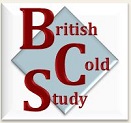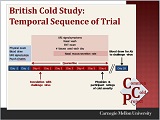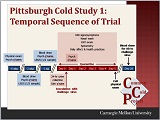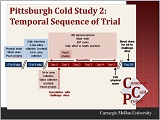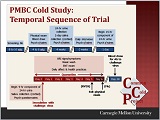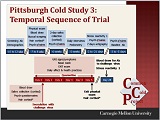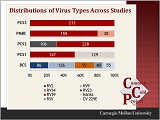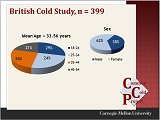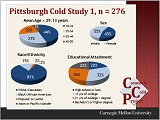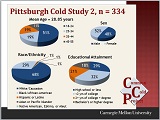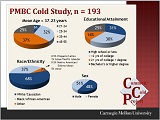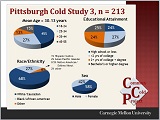The 5 Studies
Detailed descriptions of each of the 5 studies comprising the Common Cold Project can be obtained by following the relevant link in the left navigation column. Here we provide a brief overview of the studies and how they compare in terms of research aims, study design, and sample characteristics.
Primary Study Aims
Each of the 5 studies comprising the Common Cold Project was designed to address a specific set of hypotheses, though all assessed an extensive array of biological, psychological, and behavioral variables. See Measures by Study for a full list of measures collected in each study.
Study Designs
Whereas the BCS began data collection upon participant arrival at the Common Cold Unit, the four Pittsburgh studies (i.e., PCS1, PCS2, PMBC, PCS3) included extended pre-quarantine data collection periods of varying lengths. Data collected during this time included psychological measures, urinary catecholamines (PCS2, PMBC), saliva cortisol (PCS2, PMBC, PCS3), daily interviews (PCS2, PMBC, PCS3), and laboratory stress reactivity (PCS3). Blood draws also were performed for complete blood counts and serum chemistries, as well as for assessment of cortisol (PCS1), cytokines (PMBC), and telomere length (PCS3). PCS3 also included a post-challenge laboratory stress reactivity session. Procedures conducted while participants were in quarantine were largely identical across studies. Exceptions are as follows: 24-hour urines (for measurement of catecholamines) were collected during the first day of quarantine in all studies but PCS3; saliva (for measurement of cortisol) was collected at multiple time-points throughout the first day in quarantine in all studies but PCS1; and a single urine sample (for measurement of F2-isoprostanes) was collected on participants’ first morning in quarantine in PCS3. Additional design features are presented in Table 1.
Table 1. Design features of each of the 5 studies comprising the Common Cold Project
| BCS | PCS1 | PCS2 | PMBC | PCS3 | |
| Years data colected | 1986-1989 | 1993-1996 | 1997-2001 | 2000-2004 | 2007-2011 |
| Timing of pre-quarantine data collections | n/a |
2 weeks pre; 1 week pre |
7-8 weeks pre; 2-4 week pre |
4-6 weeks pre; 3 weeks pre |
7-8 weeks pre; 6 weeks pre; 5 weeks pre; 3 weeks pre; 3-5 days pre |
| Days in quarantine | 6 | 5 | 5 |
5 (RV39) or 6 (flu) |
5 |
| Virus(es) |
RV2 (n=86) RV9 (n=126)RV14 (n=92) RSV (n=40) CV 229E (n=55) |
RV39(n=147) Hanks (n=129) |
RV39 (n=228) RV23 (n=106) |
RV39 (n=155) Influenza A (n=38) |
RV39 (n=213) |
| Maximum screening Ab titer | none | none | none | 4 | 4 |
RV = Rhinovirus. RSV = Respiratory Syncytial Virus. CV = Coronavirus.
Design Slides Available for Download
|
|
|
|
|
|
|
|
Study Samples
Table 2 presents description information about the sample populations employed in each of the 5 studies. With the exception of age, participants were not selected or excluded based on any demographic characteristic.
Table 2. Sample demographic characteristics
| BCS | PCS1 | PCS2 | PMBC | PCS3 | |
| Sample size | 399 | 276 | 334 | 193 | 213 |
| Age range (years) | 18-54 | 18-55 | 18-54 | 21-55 | 18-55 |
| % Female | 62% | 55% | 52% | 51% | 42% |
|
Race/Ethnicity White/Caucasian Black/African-American Other† |
Data not collected |
81% 15% 4% |
68% 30% 2% |
56% 37% 7% |
67% 27% 6% |
|
Education High school or less <2 years of college >2 years of college + degree Bachelor's or higher degree |
Although BCS education data are available, British levels do not conform to standard U.S. categorization. | 20% 32% 26% 22% |
29% 32% 21% 18% |
31% 30% 14% 25% |
24% 27% 24% 25% |
| Currently employed | 63% | 62% | 57% | 56% | 60% |
|
Marital Status Married/marital-like Never married Separated Divorced Widowed |
40% 40% 3% 16% 1% |
27% 51% 5% 16% <1% |
25% 57% 5% 13% <1% |
35% 42% 7% 14% 2% |
15% 73% 5% 7% <1% |
†Additional race/ethnicity categories include Hispanic or Latino; Asian or Pacific Islander; Native American, Eskimo, or Aleut; and Other (e.g., mixed race)
Sample Description Slides Available for Download
|
|
|
|
|
|
|
